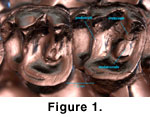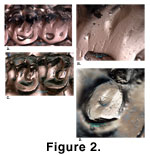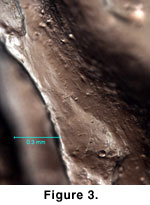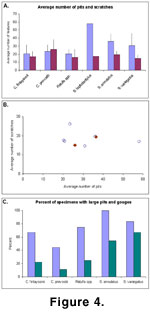MATERIALS AND METHODS
We examined fossil
sciurid specimens from Miocene sediments of Pakistan and Pliocene deposits from
the central plains of the United States. The Miocene Siwalik record of northern
Pakistan has provided a rich record of rodent evolution (Jacobs et al. 1989;
Barry et al. 2002). Sciurids are a minor but persistent component of Siwalik
small-mammal assemblages; their presence is documented in fossil assemblages
ranging in age from 18 to 7 Ma (Flynn 2003). The two Siwalik fossils belong to
unnamed species of the chipmunk genus Eutamias. Fossils of
Spermophilus rexroadensis are from the upper Pliocene (late Blancan) of
Meade County, Kansas (Hibbard 1941;
Bell et al. 2004).
 Microwear was
measured on the metaconule of upper second molars for all modern species, and on
upper first or second molars for the fossil species; for one specimen of fossil
Eutamias, an upper third molar was measured (Figure 1,
Figure 2,
Figure 3). The advantage
of sampling the metaconule was that it provided a relatively large, flat,
occlusal surface toward the center of the tooth where most food processing takes
place. Over a range of wear stages, the metaconule consistently showed microwear
features on squirrel teeth.
Microwear was
measured on the metaconule of upper second molars for all modern species, and on
upper first or second molars for the fossil species; for one specimen of fossil
Eutamias, an upper third molar was measured (Figure 1,
Figure 2,
Figure 3). The advantage
of sampling the metaconule was that it provided a relatively large, flat,
occlusal surface toward the center of the tooth where most food processing takes
place. Over a range of wear stages, the metaconule consistently showed microwear
features on squirrel teeth.
 Microwear was
measured on clear epoxy casts of modern and fossil specimens. All specimens were
first cleaned with acetone and cotton swabs. Once dry, each tooth was molded
twice using a high-precision, polyvinylsiloxane dental-impression material by
President Jet® (Coltene/ Whaledent). The first mold was discarded as
a final cleaning step. The second mold was surrounded by a ribbon of putty to
contain the casting material. Casts were made using clear epoxy resin (Epo-kwick®
resin and hardener from Buehler). Once the epoxy was mixed and poured, the molds
were placed in a vacuum chamber to remove air bubbles and were then left to cure
for two days.
Microwear was
measured on clear epoxy casts of modern and fossil specimens. All specimens were
first cleaned with acetone and cotton swabs. Once dry, each tooth was molded
twice using a high-precision, polyvinylsiloxane dental-impression material by
President Jet® (Coltene/ Whaledent). The first mold was discarded as
a final cleaning step. The second mold was surrounded by a ribbon of putty to
contain the casting material. Casts were made using clear epoxy resin (Epo-kwick®
resin and hardener from Buehler). Once the epoxy was mixed and poured, the molds
were placed in a vacuum chamber to remove air bubbles and were then left to cure
for two days.
 Casts were
subsequently examined under a stereo light microscope at 70X magnification using
the Solounias and
Semprebon (2002) technique. We examined a 0.3 mm X 0.3 mm area
on the metaconule of each specimen (Figure 1). On each tooth, we documented
eight microwear variables: two continuous variables—the number of pits and the
number of scratches; and four categorical variables—the presence/absence of at
least four gouges, at least four large pits, and cross scratches; and the
texture of the scratches, i.e., whether they were predominantly coarse, fine, or
a mix of coarse and fine. Pits were defined as those features that are generally
circular. Small pits were shallow and hence highly refractive. Large pits were
deeper, wider, and reflected less light. Gouges were very irregularly shaped
large pits. Scratches were features with greater lengths than widths and with
parallel sides. Cross scratches were those running at angles to one another.
Scratches were categorized as fine (narrow and shallow) or coarse (wider and
deeper). These are the microwear variables measured by
Solounias and
Semprebon (2002). The Appendix contains data for the six microwear variables for
53 modern specimens and six fossil specimens.
Casts were
subsequently examined under a stereo light microscope at 70X magnification using
the Solounias and
Semprebon (2002) technique. We examined a 0.3 mm X 0.3 mm area
on the metaconule of each specimen (Figure 1). On each tooth, we documented
eight microwear variables: two continuous variables—the number of pits and the
number of scratches; and four categorical variables—the presence/absence of at
least four gouges, at least four large pits, and cross scratches; and the
texture of the scratches, i.e., whether they were predominantly coarse, fine, or
a mix of coarse and fine. Pits were defined as those features that are generally
circular. Small pits were shallow and hence highly refractive. Large pits were
deeper, wider, and reflected less light. Gouges were very irregularly shaped
large pits. Scratches were features with greater lengths than widths and with
parallel sides. Cross scratches were those running at angles to one another.
Scratches were categorized as fine (narrow and shallow) or coarse (wider and
deeper). These are the microwear variables measured by
Solounias and
Semprebon (2002). The Appendix contains data for the six microwear variables for
53 modern specimens and six fossil specimens.
 The number of pits
and the number of scratches exhibited the greatest variation among specimens
(Appendix) and thus showed the greatest potential for discriminating
differences in diet. We determined the mean and standard deviation of the number
of pits and the number of scratches (Figure 4A) and plotted the differences in
average number of pits and scratches for all of the modern species (Figure 4B).
Rather than assume that these variables are normally distributed, we used
nonparametric tests to assess whether the differences among species were
statistically significant. We used a Kruskal-Wallis test to determine whether
the average number of pits and scratches differed significantly among modern
species. The Kruskal-Wallis test is a nonparametric analogue of the one-way
analysis of variance (Lowry 2004b). In this test, the raw data are converted to
ranks across the entire data set; then differences in the means of ranks among
samples are compared. The test statistic is approximated by the chi-square
distribution. In addition, we used the Mann-Whitney test, corrected for ties, to
determine whether the tree squirrels and ground squirrels differed individually
or as a group based on the number of pits (Table 2A) and the number of scratches
(Table 2B). The Mann-Whitney test is the nonparametric analogue of the t-test
and indicates whether two samples differ significantly according to the ranks of
their variates (Lowry 2004a). The test statistic can be converted into a z-ratio
for the unit-normal distribution.
The number of pits
and the number of scratches exhibited the greatest variation among specimens
(Appendix) and thus showed the greatest potential for discriminating
differences in diet. We determined the mean and standard deviation of the number
of pits and the number of scratches (Figure 4A) and plotted the differences in
average number of pits and scratches for all of the modern species (Figure 4B).
Rather than assume that these variables are normally distributed, we used
nonparametric tests to assess whether the differences among species were
statistically significant. We used a Kruskal-Wallis test to determine whether
the average number of pits and scratches differed significantly among modern
species. The Kruskal-Wallis test is a nonparametric analogue of the one-way
analysis of variance (Lowry 2004b). In this test, the raw data are converted to
ranks across the entire data set; then differences in the means of ranks among
samples are compared. The test statistic is approximated by the chi-square
distribution. In addition, we used the Mann-Whitney test, corrected for ties, to
determine whether the tree squirrels and ground squirrels differed individually
or as a group based on the number of pits (Table 2A) and the number of scratches
(Table 2B). The Mann-Whitney test is the nonparametric analogue of the t-test
and indicates whether two samples differ significantly according to the ranks of
their variates (Lowry 2004a). The test statistic can be converted into a z-ratio
for the unit-normal distribution.

 Microwear was
measured on the metaconule of upper second molars for all modern species, and on
upper first or second molars for the fossil species; for one specimen of fossil
Eutamias, an upper third molar was measured (Figure 1,
Figure 2,
Figure 3). The advantage
of sampling the metaconule was that it provided a relatively large, flat,
occlusal surface toward the center of the tooth where most food processing takes
place. Over a range of wear stages, the metaconule consistently showed microwear
features on squirrel teeth.
Microwear was
measured on the metaconule of upper second molars for all modern species, and on
upper first or second molars for the fossil species; for one specimen of fossil
Eutamias, an upper third molar was measured (Figure 1,
Figure 2,
Figure 3). The advantage
of sampling the metaconule was that it provided a relatively large, flat,
occlusal surface toward the center of the tooth where most food processing takes
place. Over a range of wear stages, the metaconule consistently showed microwear
features on squirrel teeth.

